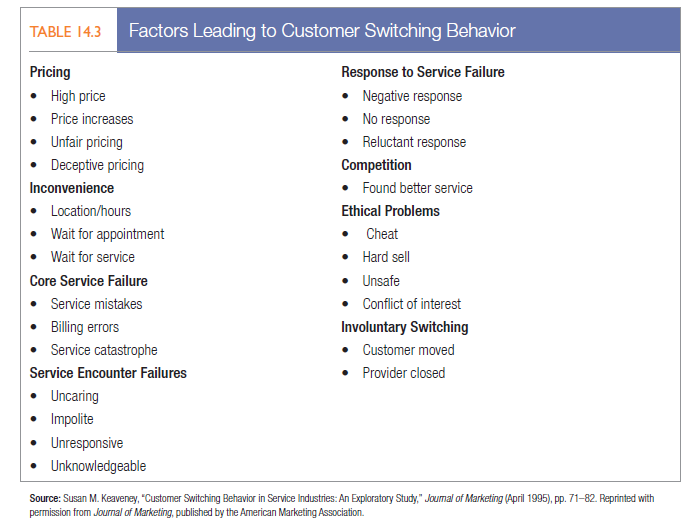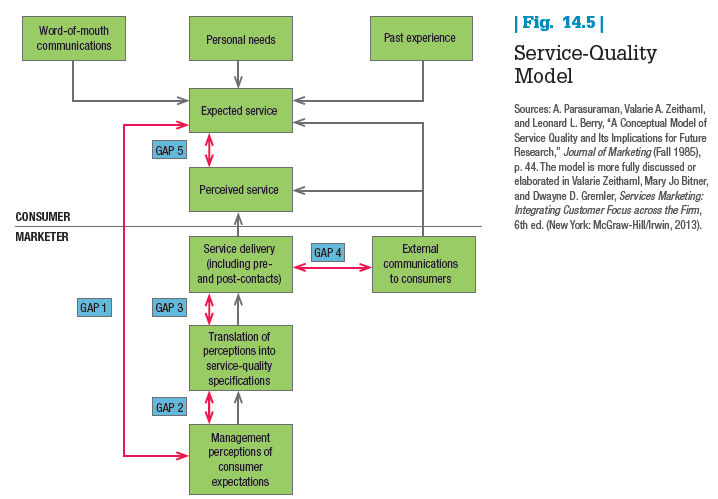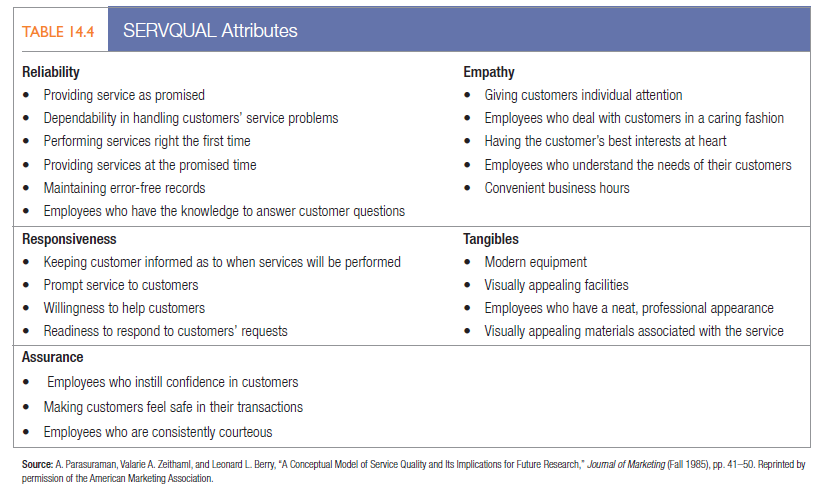The service quality of a firm is tested at each service encounter. If employees are bored, cannot answer simple questions, or are visiting each other while customers are waiting, customers will think twice about doing business there again. Wells Fargo has succeeded in the banking industry by focusing on its customers and delivering superior service.75
WELLS FARGO Through acquisitions and steady growth, Wells Fargo has become the largest U.S. bank. Marketing has also played a key role. The company’s stagecoach symbol reinforces heritage and experience, but it’s the way Wells Fargo operates that ensures continued success, beginning with a customer-focused corporate culture that aims to “treat the customer right.” The bank also sees a financial benefit to its customer focus. As its values handbook notes:
The core of our vision and our strategy is “cross-selling.” . . . The more we give our customers what they need, the more we know about them. The more we know about their other financial needs, the easier it is for them to bring us more of their business. The more business they do with us, the better value they receive, the more loyal they are.
Given the diverse nature of its customer base in California, Wells Fargo actively seeks and trains a diverse workforce. The average customer uses 5.2 different bank products, roughly twice the industry average, thanks in part to the teamwork of the company’s highly motivated staff. Wells Fargo’s market share declined from 2003 to 2006, but because it also avoided issuing risky mortgages, its stock has delivered a 25 percent return over the past 10 years, comparable to Goldman Sachs and better than many other large banks.
Service outcome and customer loyalty are influenced by a host of variables. One study identified more than 800 critical behaviors that cause customers to switch services; see the eight categories of those behaviors in Table 14.3.76 A more recent study honed in on the service dimensions customers would most like companies to measure. Knowledgeable frontline workers and the ability to achieve one-call-and-done rose to the top.77
Flawless service delivery is the ideal output for any service organization. “Marketing Memo: Recommendations for Improving Service Quality” offers a comprehensive set of guidelines to which top service marketing organizations can adhere. Two top activities are managing customer expectations and incorporating self-service technologies.

1. MANAGING CUSTOMER EXPECTATIONS
Customers form service expectations from many sources, such as past experiences, word of mouth, and advertising. In general, they compare perceived and expected service. If the perceived service falls below the expected service, customers are disappointed. Successful companies add benefits to their offering that not only satisfy customers but surprise and delight them by exceeding expectations.78 One company that has built its business around exceeding customer expectations is American Express.79
AMERICAN EXPRESS Under the direction of Executive VP Jim Bush, American Express has embraced a relationship-building approach in which customer service reps are judged in part on whether customers say they would recommend the brand to friends or family (NPS or Net Promoter Score; see Chapter 5). Reps—called customer care professionals—can see all kinds of relevant data on their screen when a customer calls, including name, age, address, and buying and payment habits. Whether a cardmember loses a wallet or purse while traveling or needs assistance finding a missing child in a foreign country, American Express has empowered its customer care professionals to do whatever it takes to help. This exemplary customer service brings financial benefits too. Cardmembers designated promoters on the basis of NPS score increase their AmEx card spending 10 percent to 15 percent and are four to five times more likely to remain customers, increasing shareholder value. Not least, because of its strong service culture and support, American Express boasts some of the highest employee retention rates in the industry.
The service-quality model in Figure 14.5 highlights the main requirements for delivering high service quality.80 It identifies five gaps that prevent successful delivery:
- Gap between consumer expectation and management perception—Management does not always correctly perceive what customers want. Hospital administrators may think patients want better food, but patients may be more concerned with nurse responsiveness.
- Gap between management perception and service-quality specification—Management might correctly perceive customers’ wants but not set a performance standard. Hospital administrators may tell the nurses to give “fast” service without specifying speed in minutes.
- Gap between service-quality specifications and service delivery—Employees might be poorly trained or incapable of or unwilling to meet the standard; they may be held to conflicting standards, such as taking time to listen to customers and serving them fast.
- Gap between service delivery and external communications—Consumer expectations are affected by statements made by company representatives and ads. If a hospital brochure shows a beautiful room but the patient finds it cheap and tacky-looking, external communications have distorted the customer’s expectations.
- Gap between perceived and expected service—The consumer may misperceive the service quality. The physician may keep visiting the patient to show care, but the patient may interpret this as an indication that something is really wrong.

Based on this service-quality model, researchers identified five determinants of service quality, in descending order of importance:81
- Reliability—The ability to perform the promised service dependably and accurately.
- Responsiveness—The willingness to help customers and provide prompt service.
- Assurance—The knowledge and courtesy of employees and their ability to convey trust and confidence.
- Empathy—The provision of caring, individualized attention to customers.
- Tangibles—The appearance of physical facilities, equipment, staff, and communication materials.
Based on these five factors, the researchers developed the 21-item SERVQUAL scale (see Table 14.4).82 They also note there is a zone of tolerance, or a range in which a service dimension would be deemed satisfactory, anchored by the minimum level consumers are willing to accept and the level they believe can and should be delivered.

Subsequent research has extended the service-quality model. One dynamic process model of service quality was based on the premise that customer perceptions and expectations of service quality change over time, but at any one point they are a function of prior expectations about what will and what should happen during the service encounter, as well as the actual service delivered during the last contact.83 Tests of the dynamic process model reveal that the two different types of expectations have opposite effects on perceptions of service quality.
- Increasing customer expectations of what the firm will deliver can lead to improved perceptions of overall service quality.
- Decreasing customer expectations of what the firm should deliver can also lead to improved perceptions of overall service quality.
Much work has validated the role of expectations in consumers’ interpretations and evaluations of the service encounter and in the relationship they adopt with a firm over time.84 Consumers are often forward-looking with respect to their decision to keep or drop a service relationship in terms of their likely behavior and interactions with a firm. Any marketing activity that affects current or expected future usage can help to solidify a service relationship.
With continuously provided services, such as public utilities, health care, financial and computing services, insurance, and other professional, membership, or subscription services, customers have been observed to mentally calculate their payment equity—the perceived economic benefits in relationship to the economic costs. In other words, customers ask themselves, “Am I using this service enough, given what I pay for it?” A negative response will lead to change in behavior and possible termination of an account.
Long-term service relationships can have a dark side. An ad agency client may feel that over time the agency is losing objectivity, becoming stale in its thinking, or beginning to take advantage of the relationship.
2. MARKETING MEMO Recommendations for Improving Service Quality
Pioneers in conducting academic service research, Berry, Parasuraman, and Zeithaml offer 10 lessons they maintain are essential for improving service quality across service industries.
- Listening—Service providers should understand what customers really want through continuous learning about the expectations and perceptions of customers and noncustomers (for instance, by means of a service-quality information system).
- RefeM/y—Reliability is the single most important dimension of service quality and must be a service priority.
- Basic service—Service companies must deliver the basics and do what they are supposed to do—keep promises, use common sense, listen to customers, keep customers informed, and be determined to deliver value to customers.
- Service design—Service providers should take a holistic view of the service while managing its many details.
- Recovery—To satisfy customers who encounter a service problem, service companies should encourage customers to complain (and make it easy for them to do so), respond quickly and personally, and develop a problem-resolution system.
- Surprising customers—Although reliability is the most important dimension in meeting customers’ service expectations, process dimensions such as assurance, responsiveness, and empathy are most important in exceeding customer expectations, for example, by surprising them with uncommon swiftness, grace, courtesy, competence, commitment, and understanding.
- Fair p/ay^—Service companies must make special efforts to be fair, and to demonstrate fairness, to customers and employees.
- Teamwork—Teamwork is what enables large organizations to deliver service with care and attentiveness by improving employee motivation and capabilities.
- Employee research—Marketers should conduct research with employees to reveal why service problems occur and what companies must do to solve problems.
- Servant leadership—Quality service comes from inspired leadership throughout the organization; from excellent service-system design; from the effective use of information and technology; and from a slow-to-change, invisible, all-powerful, internal force called corporate culture.
Sources: Leonard L. Berry, A. Parasuraman, and Valarie A. Zeithaml, “Ten Lessons for Improving Service Quality,” MSI Reports Working Paper Series, No.03-001 (Cambridge, MA: Marketing Science Institute, 2003), pp. 61-82. See also Leonard L. Berry, Venkatesh Shankar, Janet Parish, Susan Cadwallader, and Thomas Dotzel,
“Creating New Markets through Service Innovation,” S/oan Management Review (Winter 2006), pp. 56-63; and Leonard L. Berry, Kathleen Seiders, and Dhruv Grewal, “Understanding Service Convenience,” Journal of Marketing (July 2002), pp. 1-17.
3. INCORPORATING SELF-SERVICE TECHNOLOGIES (SSTS)
Consumers value convenience in services,86 and many person-to-person service interactions are being replaced by self-service technologies (SSTs) intended to provide that convenience. To traditional vending machines we can add automated teller machines (ATMs), self-pumping at gas stations, self-checkout at hotels, and a variety of activities on the Internet, such as ticket purchasing, investment trading, and customization of products.
Chili’s is installing tabletop computer screens in its restaurants so customers can order directly and pay by credit card. The restaurant found users of the service spend more per check, in part because they buy more desserts and coffee when the screen is present.87 You can add an app like WaitAway to your cell phone and be contacted by text message when your table is ready at a restaurant—and monitor the length of the line in the process.88 OpenTable lets you easily book the reservation ahead of time.89
OPENTABLE OpenTable has become the world’s largest online reservation system, letting users book a reservation on its Web site or with its smart-phone app at thousands of restaurants around the world. A new deal with Facebook allows users to book on a restaurant’s Facebook page. For a fairly modest setup charge and monthly fee—$249 a month for software to manage bookings plus $1 for every diner seated through the Web site—a restaurant can tap into OpenTable’s vast customer base. With half of all restaurants in North America signed up and more than 15 million people seated monthly via the Web site, the service has been adding functionality. For instance, the acquisition of Foodspotting for $10 million allows users to search menu images by dish. Now more than 40 percent of its reservations are booked via phone or tablet, OpenTable is beefing up its mobile strategy and adding payment services with a new app. Its new priority is to take the massive amounts of data it has collected on users’ dining preferences to offer customized dining recommendations.
Not all SSTs improve service quality, but they can make service transactions more accurate, convenient, and faster. Obviously, they can also reduce costs. One technology firm, Comverse, estimates the cost to answer a query through a call center at $7, but online at only 10 cents. One of Comverse’s clients was able to direct 200,000 calls a week through online self-service support, saving $52 million a year.90
Every company needs to think about improving its service using SSTs. Comcast can offer less customer service because 40 percent of its installations are done by the customer and 31 percent of customers now manage their accounts completely online.91
Successfully integrating technology into the workforce thus requires a comprehensive reengineering of the front office to identify what people do best, what machines do best, and how to deploy them separately and together.92 Some companies have found the biggest obstacle is not the technology itself, but convincing customers to use it, especially for the first time.
Customers must have a clear sense of their roles in the SST process, must see a clear benefit, and must feel they can actually use it.93 SST is not for everyone. Although some automated voices are actually popular with customers—the unfailingly polite and chipper voice of Amtrak’s “Julie” has been generally well-received by callers—many can incite frustration and even rage.94
Source: Kotler Philip T., Keller Kevin Lane (2015), Marketing Management, Pearson; 15th Edition.

I’m not that much of a internet reader to be honest but your sites really nice, keep it up! I’ll go ahead and bookmark your website to come back later. Many thanks